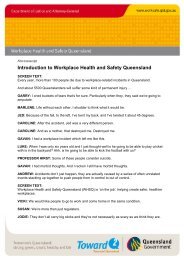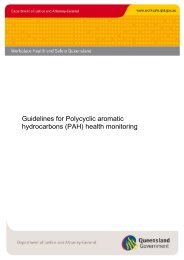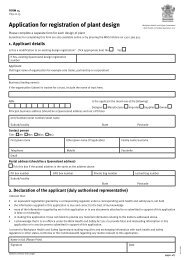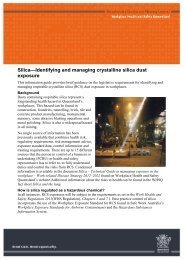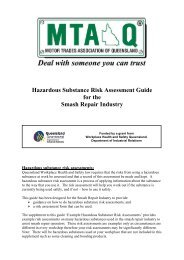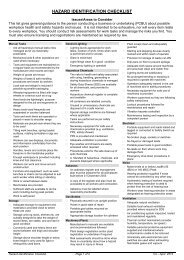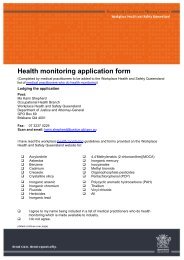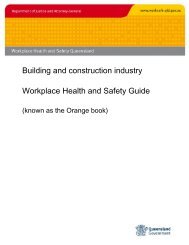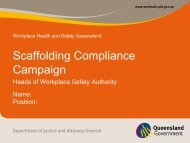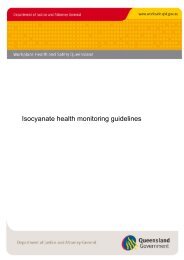A guide to the Dangerous Goods Safety Management Act 2001
A guide to the Dangerous Goods Safety Management Act 2001
A guide to the Dangerous Goods Safety Management Act 2001
You also want an ePaper? Increase the reach of your titles
YUMPU automatically turns print PDFs into web optimized ePapers that Google loves.
Additional specific requirements are outlined below.<br />
6.2 Risk Assessment<br />
An occupier must make and record an assessment of <strong>the</strong> risk <strong>to</strong> people, property or <strong>the</strong> environment from <strong>the</strong><br />
stated dangerous goods (See Section 2.12), hazardous materials and combustible liquids at <strong>the</strong> location and<br />
of any work practices needed <strong>to</strong> comply with <strong>the</strong> legislation.<br />
The assessment process must start with <strong>the</strong> identification of <strong>the</strong> goods and <strong>the</strong>ir hazards, <strong>the</strong>n progress<br />
through a number of specified steps until plans for managing risk are formulated. Each step and <strong>the</strong><br />
resultant outcomes must be documented. These steps are <strong>to</strong> be found in Sections 66 and 67 of <strong>the</strong><br />
<strong>Dangerous</strong> <strong>Goods</strong> <strong>Safety</strong> <strong>Management</strong> <strong>Act</strong> <strong>2001</strong> Regulation, a copy of which can be found at<br />
http://www.emergency.qld.gov.au/chem/legislation.<br />
Whenever a work practice involving <strong>the</strong> stated dangerous goods and combustible liquids is significantly<br />
changed, or new information about materials becomes available, <strong>the</strong> risk assessment must be amended <strong>to</strong><br />
incorporate current information.<br />
6.3 <strong>Safety</strong> <strong>Management</strong> System<br />
The occupier must develop, implement and maintain a documented system for managing <strong>the</strong> safety of<br />
dangerous goods and combustible liquids at <strong>the</strong> DGL. The safety management system must include <strong>the</strong><br />
following details:<br />
• <strong>the</strong> system’s safety objectives;<br />
• <strong>the</strong> systems and procedures by which <strong>the</strong> objectives are <strong>to</strong> be met;<br />
• <strong>the</strong> performance criteria that are <strong>to</strong> be met; and<br />
• <strong>the</strong> way in which adherence <strong>to</strong> <strong>the</strong> criteria is <strong>to</strong> be maintained.<br />
6.4 Protective Measures<br />
The DGSM Regulation identifies a number of specific protective measures that an occupier must implement<br />
at a DGL in relation <strong>to</strong> <strong>the</strong> s<strong>to</strong>rage and handling of stated dangerous goods (See Section 2.12) and combustible<br />
liquids. These measures include:<br />
• consider substitution with less dangerous goods, or reduction of <strong>the</strong>ir quantity;<br />
• proper design, construction, installation and management of s<strong>to</strong>rage or handling systems,<br />
especially bulk tanks;<br />
• proper planning of <strong>the</strong> introduction of new procedures;<br />
• provision of induction, information, training and supervision for visi<strong>to</strong>rs and workers;<br />
• provision of personal protective equipment;<br />
• prevention of access by unauthorised persons;<br />
• prevention of dangerous goods from inadvertently becoming unstable, decomposing or<br />
undergoing hazardous changes;<br />
17





